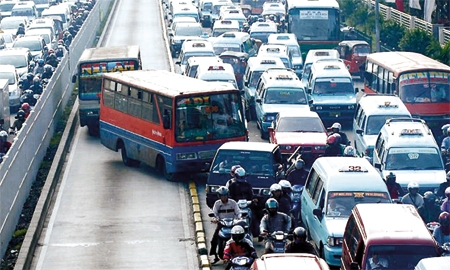Arguably the greatest obstacle hindering Indonesia’s achievement of double-digit GDP growth is insufficient connectivity, caused by inadequate infrastructure development in recent years. Indonesia is ASEAN’S largest member by population and its GDP ranked 59th out of 155 countries in the World Bank’s ‘Logistics Point Index’ published in May 2012. Whilst a notable rise from 2010’s position of 75th, this remains below regional neighbours Singapore, Malaysia and Thailand. “As a government we have been spending far less on infrastructure than we have on subsidies; this is the sad fact behind the current situation,” says Luky Eko Wuryanto, the Deputy for Infrastructure within the Coordinating Ministry of Economic Affairs.
However, there has been a noticeable commitment on the part of the government to change this in 2012, with President SBY announcing an increase of 19% in government spending on infrastructure development. Additionally, 75% of the 24 trillion rupiah (EUR 2 billion) in unspent funds remaining from the government’s budget from fiscal year 2011 has been assigned to the cause.
The Ministry of National Development and Planning (BAPPENAS) estimated that 1,400 trillion rupiah was required between 2010 and 2014 to fund necessary infrastructure development. Of this, the government was deemed capable of contributing just 30%. The Indonesian Economic Development Committee (KP3EI) recently confirmed this with its announcement that 84 projects worth 536.3 trillion rupiah (EUR 4.6 billion) would commence in 2012 – of which 15 would be financed by the government, 20 by state-owned enterprises, 35 by private sector entities and the remaining through a ‘Public Private Partnership’ (PPP) model.
Dedy Priatna, the Deputy Minister for Infrastructure within BAPPENAS displayed confidence in the longevity of Indonesia’s transition towards PPPs for future development. “Of the 84 projects this year 15-20% will be PPP’s. In 2013 I expect PPPs to go to 25% and in 2014 to 35%. BAPPENAS will continue to develop our PPP model and support investors as they enter into such agreements,” he said.
Such support shall come in the form of government incentives and compensation for private investors. Starting next year for example, a ‘Viability Gap Fund’ shall serve as financial leverage for government-sanctioned projects that are less commercially-attractive.
When you consider toll road development, one cannot help but compare the 125 kilometres of toll road developed during President SBY’s entire first term with the 4,719 kilometres constructed in China during 2009 alone. “Toll roads have not served as a ‘sweet’ investment up until now due to the substantial risks involved, ranging from indeterminate traffic rate outside of Jakarta, unpredictability of government regulations, and limited financial support and project guarantees,” said Achmad Gani Ghazali Akman, the Head of the Indonesian Toll Road Authority (BPJT).
However, times have changed and infrastructure development should be seen not as a challenge, but as an opportunity. China has displayed such an attitude, recently expressing its interest in developing four railway systems in Indonesia, representing an investment of EUR 4 billion. Nusantara Infrastructure – an investment holding company with subsidiaries engaged in toll road, sea port, and other infrastructure related business – recorded a net profit, for the first time in three years, of 6 billion rupiah in the first quarter of this year. Last year, Thiess Indonesia signed three toll road concession agreements through subsidiary companies, capitalising on the government incentives for such projects which include up to 95% foreign ownership.
Indonesia offers potential infrastructure projects that could serve as feats worthy of global recognition for confident investors that adopt a long-term approach towards the country, with the Sunda Strait Bridge serving as the perfect example. The feasibility study will commence in 2012 and is expected to take two years, after which time the tender process shall begin. This bridge will connect Indonesia’s two most populous islands – Java and Sumatra – and in doing so bring Indonesia’s commercial hub into closer contact with a location rich in natural resources.
Whilst projects of this scale would have been previously unthinkable, the momentous Land Acquisition Law passed by the House of Representatives (DPR-RI) on December 16 brings a long-awaited sense of reality. The law – which has been subject to substantial discussion – shall reduce the time and cost needed to expropriate land, and establishes a 436 day deadline for the entire land acquisition process. However, a Presidential Decree is required to support the law’s implementation. “Such a decree will be fundamental to its success in streamlining the development process. With protests surrounding potential fuel subsidy removal and recent toll road construction, correct enforcement will be required,” says Dedy Priatna.
Crucial to Indonesia’s competitiveness come ASEAN 2015 and greater regional integration is the spread of physical development towards the east of Indonesia. “The pricing of goods in more developed areas is significantly more affordable than in the less developed eastern parts. For instance, the price of cement in Papua is 20 times higher than in Java,” said Dr Hermanto Dardak, Deputy Minister for Public Works. “The government shall subsidise build-operate-transfer (BOT) models in less developed areas to bring in foreign investors and improve the archipelago’s connectivity.”
With approximately 17,000 islands, the need for maritime infrastructure is significant. The regulatory framework is being fine-tuned, financial assistance is there, and the government is displaying the necessary political will. The time is now to invest in Indonesian infrastructure.

0 COMMENTS